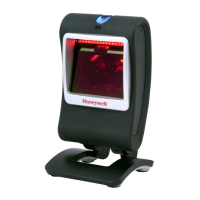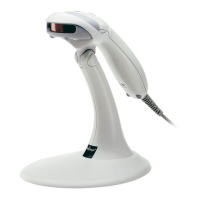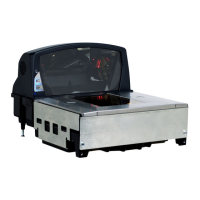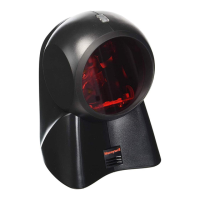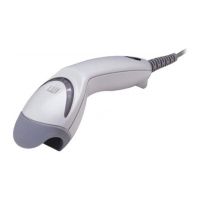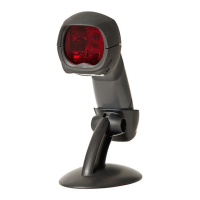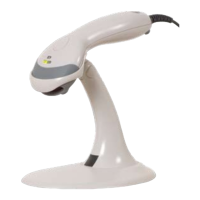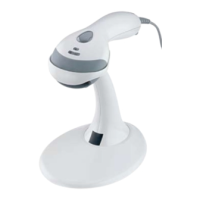Do you have a question about the Honeywell MetroSelect and is the answer not in the manual?
Explains scanner configuration via Single-Code and Multi-Code methods for setting features.
Configuration for UPC and EAN bar codes, including enable/disable and format settings.
Settings for Code 128 bar codes, including formatting and character handling.
Options for Code 39 bar codes, such as check digit requirements and ASCII support.
Configuration for Interleaved 2 of 5, Standard 2 of 5, and Matrix 2 of 5 bar codes.
Codabar bar code formatting, including start/stop characters and check digits.
Configuration options for Code 93 bar codes.
Code 11 formatting and check digit transmission settings.
Telepen bar code configuration and character conversion.
Plessey bar code formatting, including check digits and special formats.
Advanced decoding features like double border requirements and small border detection.
Setting specific code lengths for bar codes using lock mechanisms.
Configuration for GS1 DataBar symbologies, including border requirements and data transmission.
Guides ISBT Code 128 implementation, including configuration modes and data handling.
Configures time requirements for finding sequential bar codes in concatenation sequences.
Allows users to define custom concatenation sequences using specific identifiers.
Sets RS232 serial communication parameters, including parity, baud rate, and handshaking.
Manages keyboard emulation, country settings, terminal types, and special keyboard features.
Configures USB interface settings, including emulation modes and default settings.
Determines how the scanner enters configuration mode, either on power-up or anytime.
Sets the number of bar codes the scanner can hold in its scan buffer.
Configures the number of consecutive scans required for a good read.
Sets time intervals before rescanned bar codes are treated as new.
Configures scanner audible feedback, including tone types and beep behavior.
Manages delays between data characters to prevent host buffer overflow.
Defines how the scanner responds to specific commands received from the host device.
Allows assignment of custom prefix characters for all transmitted data.
Configures specific ID characters for individual bar code types as prefixes or suffixes.
Sets standard prefixes like STX, AIM, UPC, and NCR for bar code data transmission.
Configures standard suffixes such as Carriage Return, Line Feed, and Tab for bar code data.
Defines rules for replacing specific characters in the scanned data stream.
Allows assignment of custom suffix characters for all transmitted data.
Configures special formatting options like SINEKO mode and leading zero removal.
Controls formatting for UPC/EAN bar codes, including check digits and expansion.
Sets Codabar formatting options, including start/stop characters and check digits.
Configures Code 39 formatting, including Mod 43 check digit and stop/start characters.
Manages Code 11 formatting, primarily focusing on check digit transmission.
Details configuration for Telepen bar code character conversion.
Covers Plessey bar code formatting, including UK Plessey and MSI Plessey options.
Configures 2 of 5 code formats, including Mod 10 check digits and matrix options.
Sets scanner parity to match host parity for error detection (No, Odd, Space, Even, Mark).
Configures the data transmission speed (baud rate) for RS232 communication.
Enables or disables hardware handshaking (RTS/CTS) for RS232 communication.
Configures software handshaking options like ACK/NAK and XON/XOFF for reliable data transfer.
Configures keyboard emulation modes, including stand-alone and wedge emulation.
Selects the appropriate keyboard layout and scan code table for different countries.
Sets the keyboard and system type for optimal scanner compatibility.
Enables advanced keyboard features like transmit make/break codes and Alt-Mode.
Adjusts delays between scan codes to ensure compatibility with PC BIOS.
Defines translations for ASCII control characters to extended keyboard keys.
Configures the scanner for Optically Coupled Interface Adapter (OCIA) communication.
Loads default settings for OCIA communication.
Activates light pen emulation for reading bar codes.
Transmits bar codes in their original symbology.
Adjusts the minimum bar code element width for light pen/wand emulation.
Configures IBM ports for RS485 communication and selects specific port types.
Manages specific reserved codes for IBM systems.
Activates the scanner's USB interface for data communication.
Activates USB keyboard emulation for standard PC communication.
Enables uni-directional or bi-directional USB serial emulation for specific scanner models.
Configures emulation for IBM 1520 code flags, affecting ID transmission.
Provides bar codes for inputting decimal code byte values 0 through 9 for configuration.
Maps code byte values to specific bar code types for scanner configuration.
Lists ASCII values, characters, and their corresponding control keyboard equivalents.
Provides reference for extended key codes used in scanner configuration and transmission.
Sets the IR sensor activation range for sensing objects in the scan field.
Defines laser behavior, including normal, blinky, continuous blinky, and manual activation.
Sets time limits for rescanning the same bar code to avoid duplicate reads.
Configures handling for MicroPDF and composite symbologies, including GS1 DataBar linkage.
Enforces a Personal Identification Number (PIN) for Bluetooth connections.
Configures the scanner to enter sleep mode after a specified period of inactivity.
Enables or disables scanning when in the cradle and performs Bluetooth connection tests.
Stores scanned bar codes in expanded memory for later transmission via BT cradle.
Adds a field to transmit quantity for the last scanned item (1-9999).
Enables users to enter quantities (0-9) for scanned items, affecting retransmission count.
Loads Cunningham-specific default settings for the IS4125/IS4225 scan engines.
Resets the scanner to its factory default settings.
Defines how scanning is initiated, including external trigger, specific characters, or address.
Configures features related to activation modes, such as laser-on time and LED behavior.
Enables a power-saving mode that can be configured in 1-second increments.
Loads custom default settings for specific OEM applications, or resets to Honeywell defaults.
Enables serial programming for scanner configuration, requiring specific framing commands.
Provides contact information for installation and troubleshooting support by region.
Details how to obtain warranty or non-warranty service, including RMA procedures.
Offers access to technical assistance and support resources online.
Explains scanner configuration via Single-Code and Multi-Code methods for setting features.
Configuration for UPC and EAN bar codes, including enable/disable and format settings.
Settings for Code 128 bar codes, including formatting and character handling.
Options for Code 39 bar codes, such as check digit requirements and ASCII support.
Configuration for Interleaved 2 of 5, Standard 2 of 5, and Matrix 2 of 5 bar codes.
Codabar bar code formatting, including start/stop characters and check digits.
Configuration options for Code 93 bar codes.
Code 11 formatting and check digit transmission settings.
Telepen bar code configuration and character conversion.
Plessey bar code formatting, including check digits and special formats.
Advanced decoding features like double border requirements and small border detection.
Setting specific code lengths for bar codes using lock mechanisms.
Configuration for GS1 DataBar symbologies, including border requirements and data transmission.
Guides ISBT Code 128 implementation, including configuration modes and data handling.
Configures time requirements for finding sequential bar codes in concatenation sequences.
Allows users to define custom concatenation sequences using specific identifiers.
Sets RS232 serial communication parameters, including parity, baud rate, and handshaking.
Manages keyboard emulation, country settings, terminal types, and special keyboard features.
Configures USB interface settings, including emulation modes and default settings.
Determines how the scanner enters configuration mode, either on power-up or anytime.
Sets the number of bar codes the scanner can hold in its scan buffer.
Configures the number of consecutive scans required for a good read.
Sets time intervals before rescanned bar codes are treated as new.
Configures scanner audible feedback, including tone types and beep behavior.
Manages delays between data characters to prevent host buffer overflow.
Defines how the scanner responds to specific commands received from the host device.
Allows assignment of custom prefix characters for all transmitted data.
Configures specific ID characters for individual bar code types as prefixes or suffixes.
Sets standard prefixes like STX, AIM, UPC, and NCR for bar code data transmission.
Configures standard suffixes such as Carriage Return, Line Feed, and Tab for bar code data.
Defines rules for replacing specific characters in the scanned data stream.
Allows assignment of custom suffix characters for all transmitted data.
Configures special formatting options like SINEKO mode and leading zero removal.
Controls formatting for UPC/EAN bar codes, including check digits and expansion.
Sets Codabar formatting options, including start/stop characters and check digits.
Configures Code 39 formatting, including Mod 43 check digit and stop/start characters.
Manages Code 11 formatting, primarily focusing on check digit transmission.
Details configuration for Telepen bar code character conversion.
Covers Plessey bar code formatting, including UK Plessey and MSI Plessey options.
Configures 2 of 5 code formats, including Mod 10 check digits and matrix options.
Sets scanner parity to match host parity for error detection (No, Odd, Space, Even, Mark).
Configures the data transmission speed (baud rate) for RS232 communication.
Enables or disables hardware handshaking (RTS/CTS) for RS232 communication.
Configures software handshaking options like ACK/NAK and XON/XOFF for reliable data transfer.
Configures keyboard emulation modes, including stand-alone and wedge emulation.
Selects the appropriate keyboard layout and scan code table for different countries.
Sets the keyboard and system type for optimal scanner compatibility.
Enables advanced keyboard features like transmit make/break codes and Alt-Mode.
Adjusts delays between scan codes to ensure compatibility with PC BIOS.
Defines translations for ASCII control characters to extended keyboard keys.
Configures the scanner for Optically Coupled Interface Adapter (OCIA) communication.
Loads default settings for OCIA communication.
Activates light pen emulation for reading bar codes.
Transmits bar codes in their original symbology.
Adjusts the minimum bar code element width for light pen/wand emulation.
Configures IBM ports for RS485 communication and selects specific port types.
Manages specific reserved codes for IBM systems.
Activates the scanner's USB interface for data communication.
Activates USB keyboard emulation for standard PC communication.
Enables uni-directional or bi-directional USB serial emulation for specific scanner models.
Configures emulation for IBM 1520 code flags, affecting ID transmission.
Provides bar codes for inputting decimal code byte values 0 through 9 for configuration.
Maps code byte values to specific bar code types for scanner configuration.
Lists ASCII values, characters, and their corresponding control keyboard equivalents.
Provides reference for extended key codes used in scanner configuration and transmission.
Sets the IR sensor activation range for sensing objects in the scan field.
Defines laser behavior, including normal, blinky, continuous blinky, and manual activation.
Sets time limits for rescanning the same bar code to avoid duplicate reads.
Configures handling for MicroPDF and composite symbologies, including GS1 DataBar linkage.
Enforces a Personal Identification Number (PIN) for Bluetooth connections.
Configures the scanner to enter sleep mode after a specified period of inactivity.
Enables or disables scanning when in the cradle and performs Bluetooth connection tests.
Stores scanned bar codes in expanded memory for later transmission via BT cradle.
Adds a field to transmit quantity for the last scanned item (1-9999).
Enables users to enter quantities (0-9) for scanned items, affecting retransmission count.
Loads Cunningham-specific default settings for the IS4125/IS4225 scan engines.
Resets the scanner to its factory default settings.
Defines how scanning is initiated, including external trigger, specific characters, or address.
Configures features related to activation modes, such as laser-on time and LED behavior.
Enables a power-saving mode that can be configured in 1-second increments.
Loads custom default settings for specific OEM applications, or resets to Honeywell defaults.
Enables serial programming for scanner configuration, requiring specific framing commands.
Provides contact information for installation and troubleshooting support by region.
Details how to obtain warranty or non-warranty service, including RMA procedures.
Offers access to technical assistance and support resources online.
| Scanning Technology | Laser |
|---|---|
| Connectivity Technology | Wired |
| Scan Pattern | Single line |
| Interface | RS-232, Keyboard Wedge, USB |
| Humidity | 5% to 95% (non-condensing) |
| Compliance | FCC, CE |
| Light Source | 650 nm visible laser diode |
